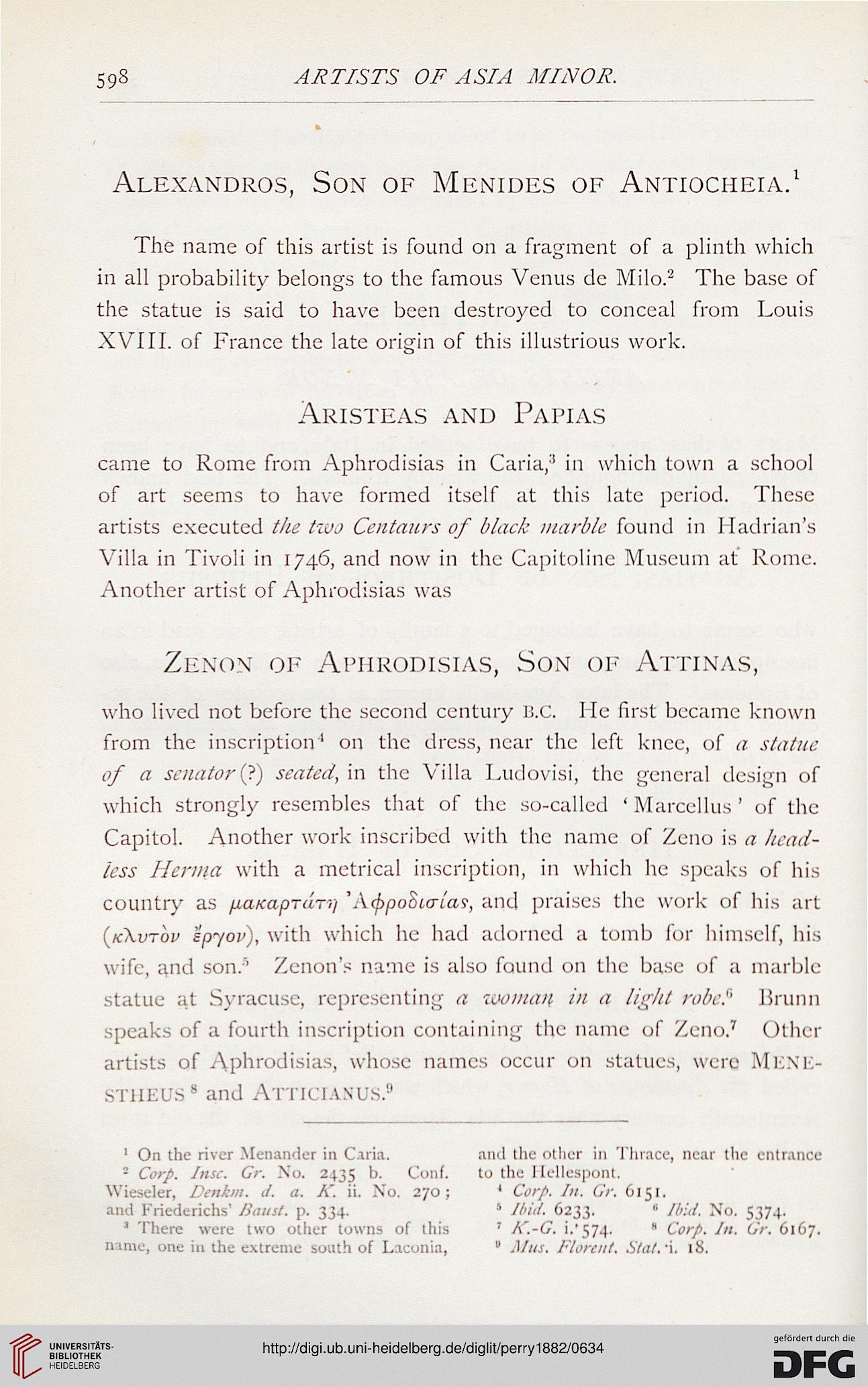59«
ARTISTS OF ASIA MINOR.
Alexandras, Son of Menides of Antiocheia.1
The name of this artist is found on a fragment of a plinth which
in all probability belongs to the famous Venus de Milo.2 The base of
the statue is said to have been destroyed to conceal from Louis
XVIII. of France the late origin of this illustrious work.
Aristeas and Papias
came to Rome from Aphrodisias in Caria/1 in which town a school
of art seems to have formed itself at this late period. These
artists executed the two Centaurs of black marble found in Hadrian's
Villa in Tivoli in 1746, and now in the Capitoline Museum at Rome.
Another artist of Aphrodisias was
Zenon of Aphrodisias, Son of Attinas,
who lived not before the second century B.C. He first became known
from the inscription1 on the dress, near the left knee, of a statue
of a senator (J) seated, in the Villa Ludovisi, the general design of
which strongly resembles that of the so-called ' Marcellus ' of the
Capitol. Another work inscribed with the name of Zeno is a head-
less Hernia with a metrical inscription, in which he speaks of his
country as p-aKapTUTr/ 'A<ppoBia-la?, and praises the work of his art
(kXvtov epyov), with which he had adorned a tomb for himself, his
wife, and son.5 Zenon's name is also found on the base of a marble
statue at Syracuse, representing a WOtnat[ in a light robe!'' Brunn
speaks of a fourth inscription containing the name of Zeno.7 Other
artists of Aphrodisias, whose names occur on statues, were Mr. MO-
ST HE US 8 and AlTlClYNUS.9
1 On the river Mcnamler in Caria.
- Corp. Insc. Gr. No. 2435 b. Conf.
Winder, Denim. J. a. K. ii. No. 270;
ami Friederichs' Bmut. p. 334.
3 There were two other towns of this
name, one in the extreme south of Laconia,
and the other in Thrace, near the entrance
to the I Hellespont
* Corp. In. Gr. 6151.
s Hid. 6233. « Ibid. No. 5374.
' A'.-G. i.' 574. ' Corp. In. Gr. 6167.
» Mus. Flottnt. Stal.'i. 18.
ARTISTS OF ASIA MINOR.
Alexandras, Son of Menides of Antiocheia.1
The name of this artist is found on a fragment of a plinth which
in all probability belongs to the famous Venus de Milo.2 The base of
the statue is said to have been destroyed to conceal from Louis
XVIII. of France the late origin of this illustrious work.
Aristeas and Papias
came to Rome from Aphrodisias in Caria/1 in which town a school
of art seems to have formed itself at this late period. These
artists executed the two Centaurs of black marble found in Hadrian's
Villa in Tivoli in 1746, and now in the Capitoline Museum at Rome.
Another artist of Aphrodisias was
Zenon of Aphrodisias, Son of Attinas,
who lived not before the second century B.C. He first became known
from the inscription1 on the dress, near the left knee, of a statue
of a senator (J) seated, in the Villa Ludovisi, the general design of
which strongly resembles that of the so-called ' Marcellus ' of the
Capitol. Another work inscribed with the name of Zeno is a head-
less Hernia with a metrical inscription, in which he speaks of his
country as p-aKapTUTr/ 'A<ppoBia-la?, and praises the work of his art
(kXvtov epyov), with which he had adorned a tomb for himself, his
wife, and son.5 Zenon's name is also found on the base of a marble
statue at Syracuse, representing a WOtnat[ in a light robe!'' Brunn
speaks of a fourth inscription containing the name of Zeno.7 Other
artists of Aphrodisias, whose names occur on statues, were Mr. MO-
ST HE US 8 and AlTlClYNUS.9
1 On the river Mcnamler in Caria.
- Corp. Insc. Gr. No. 2435 b. Conf.
Winder, Denim. J. a. K. ii. No. 270;
ami Friederichs' Bmut. p. 334.
3 There were two other towns of this
name, one in the extreme south of Laconia,
and the other in Thrace, near the entrance
to the I Hellespont
* Corp. In. Gr. 6151.
s Hid. 6233. « Ibid. No. 5374.
' A'.-G. i.' 574. ' Corp. In. Gr. 6167.
» Mus. Flottnt. Stal.'i. 18.




